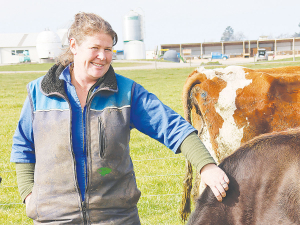Stu and Sara Russell sharemilk 750 cows in a 50/50 agreement with Sara’s parents, Richard and Diana Bourke, in Ashburton. The herd includes their registered Jerseys, Ngatimaru Jerseys, on 280 hectares through a 54-bale rotary. The land also carries all the young stock.
They are part of their processor Synlait’s Gold Elite programme, which recognises and financially rewards suppliers who achieve best practice. This is also JerseyNZ’s top production herd for more than 500-head of registered Jerseys with 497 kgMS/cow (average bodyweight of 421kg).
Stu and Sara have historically done a lot of the work on-farm themselves, using technology to maintain the pace.
When they decided they wanted to proactively track animal health in April 2021, Stu didn’t hesitate to choose smaXtec’s boluses – even though the Austrian company was relatively new to the conversation in New Zealand. They did explore other options, but Stu felt there was more accurate and critical information within the technology, and he pushed hard for them to go that way.
They were the fifth New Zealand farm to take up the option. Sara now readily acknowledges that the results have been astonishing.
The bolus sits in the cow’s reticulum – recording data 24/7. Because the measurements are internal, it brings pinpoint accuracy. The data it captures includes recording the cow’s individual temperature (accurate to within 0.01 degrees Celsius). Her rumination data is collated using a direct measure based on actual rumen contractions.
How much water she drinks, and how often she drinks is another meaningful measure. Calving alerts have also been important for this couple. Sara believes it is the most accurate calving alert system on the market (when teamed with accurate calving dates).
Heat detection – often the primary and sometimes sole motivator for New Zealand farmers to adopt animal health monitoring technology – has only been the tip of the iceberg for this operation.
Sara says the temperature function has been the biggest win for them. They are sent an alert if a cow’s temperature has a minor spike above her normal baseline temperature.It gives them the opportunity to intervene early, so they can effectively treat a cow using a non-withhold anti-inflammatory and/or a mineral bolus – avoiding the need for antibiotics.
“We pick up mastitis three days earlier than normal with this system – so nine out of 10 times when we paddle test the milk, we can treat with a non-withhold anti-inflammatory. That’s kicking 75% of our mastitis straight off,” Sara said.
“You have that ability to triage cows at the top of the hill essentially, instead of meeting them at the bottom with the ambulance.
“If you can catch them early and treat them correctly, they are often as good as gold.”
She estimates the smaXtec technology has saved them $36,000 in direct antibiotic costs and $6500 in scratchies which they didn’t have to buy for heat detection this season. That’s before she considers the added income from milk which didn’t have to be withheld, and/or her cows’ peak production and conception which wasn’t impacted by illness.
Add that to the practical reality that they haven’t had to once strip every cow in the herd this season to find any BMSCC spikes – including the time and additional wages to do it.
Knowledge Is Power
Sara Russell says every cow is different, and judgement remains important, but knowledge is undoubtedly power.
“Because that temperature is internal, it’s so accurate. The only indication one cow gave us that she was in trouble was that she spiked with a 41.3-degree temperature twice overnight. You would have had to have taken her temperature at 8.40pm to know that. We were able to get straight onto it, work out the problem, treat her, and she’s fine now.
“When it comes to RFMs [Retained Foetal Membranes], in the past we’ve typically been torn about whether to leave it another day – optimistically thinking it will come out on its own – ease it out manually, or to treat her. With smaXtec it has shown how often they run a temperature, and we now have the information to confidently say in every case what our treatment plan is.”
The ability to also share a cow’s health chart with their vets gives them a comprehensive and valuable snapshot of the cow’s health history so they can make a treatment plan together – often without necessitating a call out.
“In the past, we’ve been torn between waiting to call the vet because we’ve been undecided and then finding out a few days later that they’re a train wreck, and we’re then fighting to get them back,” Sara said.
“I’m sure we’ve also treated some cows early, when they actually didn’t need antibiotics in that instance.”
They recently completed some live biopsies to check the mineral status of the herd, and two days later one of those cow’s temperature spiked.
“I contacted our vet and together we decided to treat her with an antibiotic and anti-inflammatory. He told me that most times they wouldn’t know if there was a temperature spike after that procedure.
“She responded quickly and she’s fine now.”
Empty Rates
Heat detection has also been a success. They used sexed semen this season, achieving up to 72% conception (per straw) with an overall empty rate [for conventional and sexed semen] this spring of 10.5%.
Sara loves the control it’s given her over their herd so much she has joined the company in a customer success role. It means there is a Mid Canterbury farmer using the system who can support others who choose to take advantage of the technology.
It also gives her the confidence to step away from the farm, because she’s never away from her own herd’s information.
“Having control over an animal’s health when you’re not there always there was important for me.
“I genuinely love the system and I have a ridiculously large passion for cows. I like that smaXtec is focussed on proactive preventative animal health.
“I think it offers a huge benefit to farmers and a huge benefit for the cows, because it’s improving outcomes in our day-to-day animal management.”
















